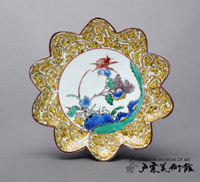Round and square. Shaped like flowers, leaves, gourds, birds, rabbits, hats and fans. Long, thin necks. Broadly rounded bodies. There are all forms seen in Imari ware, Japan’s first domestic porcelain, which arose at the beginning of the 17th century in Arita, in what is now Saga Prefecture. Imari ware made during the Edo period is generally referred to as Ko-Imari.
The kilns in Arita, which developed very rapidly into one of the world’s most important porcelain industries, created a great variety of products, adapting constantly to market demand. When the culture of tea ceremony was at its height during the first half of the 17th century, for example, the kilns in Arita produced mizusashi water jars and chaire tea caddies, as well as dishes and food cups suitable for the tasteful cha-kaiseki meals served to guests as part of tea culture. Arita also produced large dishes and sets that were used at the frequent banquets hosted by feudal lords.
In the second half of the 17th century, when exports to Europe flourished, potters learned to make new shapes such as tea pots, sugar bowls and wine goblets. And when the domestic market expanded from the 18th century, the Arita kilns moved into larger-scale production of sets of dishes and bowls, and even began to manufacture porcelain versions of common items for everyday use, such as handwarmers and trays for tobacco sets. Consumers delighted in this playfulness, and through these colorful substitutes Imari ware came to further brighten everyday life.
While many different forms emerged in accordance with function, there were also many shapes that served as part of decoration. By moving beyond building on wheels to the use of molds, many innovative new shapes became possible, often combined with other decorative elements such as painted and incised patterns.
Presented in two parts, this exhibition explores the great variety of shapes seen in Ko-Imari, approaching the subject from different angles including function, decorative design and the various techniques mused to build a form.
<Dish with foliated rim, decorated with bird and grapevine design in underglaze blue and overglaze enamels. Imari ware in Ko-Kutani style. Edo period. Mid-17th century.>

Fascinating Shapes in Ko-Imari – I
October 4, 2019 to December 9, 2019
Locations
Toguri Museum
1-11-3 Shoto,
Shibuya-ku, Tokyo 150-0046
Japan
Phone: +81-(0)3-3465-0070